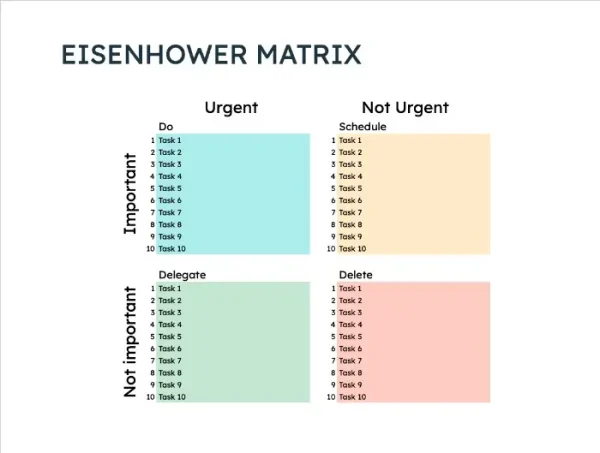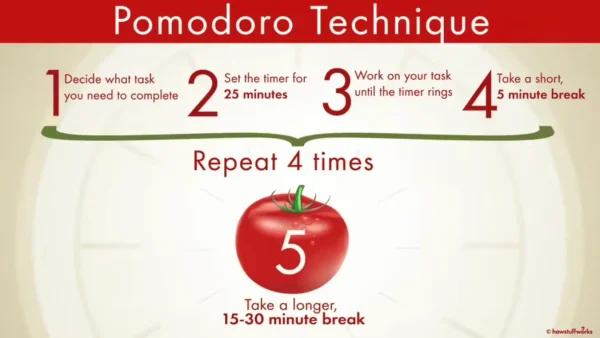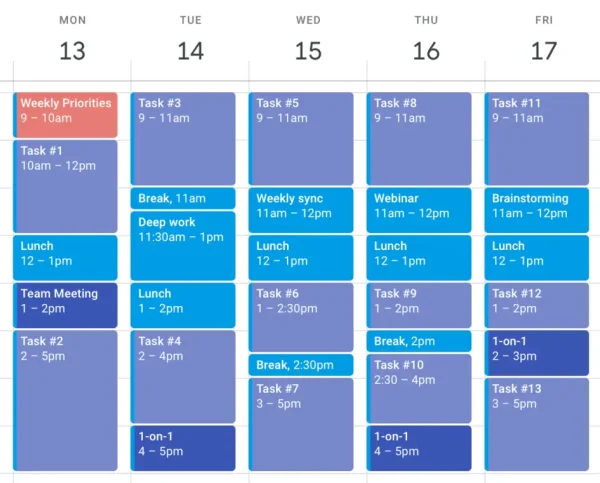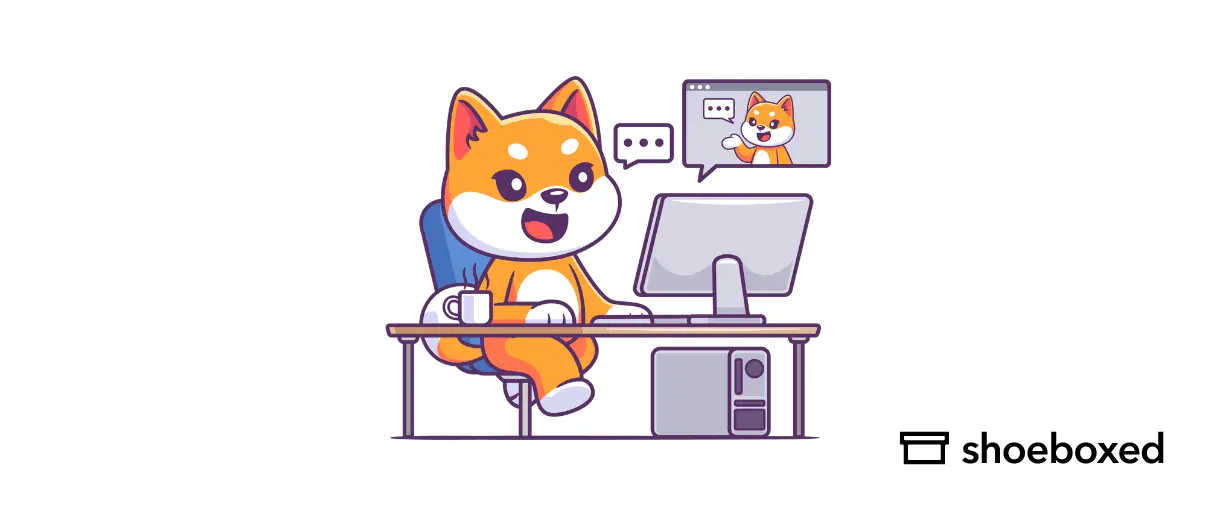If you ever feel like there are not enough hours in the day, you might just be missing out on ways to be more productive and efficient.
It can be a struggle to manage all of your work tasks and responsibilities in and outside of the office without proper planning and time management.
Knowing how to be productive will help you get the most out of your day and accomplish more in less time.
Here, we’ll share our favorite productivity tips so you can see how you can have a productive day.
1. Identify and prioritize your tasks
a. Assess your to-do list
Knowing what productivity means to you allows you to set priorities and manage your workload.
Identify what you want to accomplish for the day, either the night before or in the morning.
Ensure your list is realistic and achievable so you don’t get overwhelmed.
b. Prioritize your tasks
After writing your list, prioritize the most important tasks.
While the first task on your list might be something you need to accomplish, ask yourself how important or urgent that “to-do” is.
Knowing how to prioritize your tasks will result in more productive days. The Eisenhower Matrix is a great tool to help you decide which tasks are the most important and which are the least pressing. We’ll cover this method in more detail later.

Eisenhower Matrix in 4 quadrants
You could also use the “Do It, Defer It, Delegate It” method.
This method is great for when you’re working from home or at the office and helps you figure out which tasks you can do and which you can give to someone else.
c. Break down large projects into manageable chunks
Once you’ve decided what your priorities are for the day, you can break down these tasks into small and manageable steps.
For example, let’s say your goal today is to create a marketing plan for a new product launch.
Instead of getting overwhelmed, you could break this task down into smaller goals to complete one at a time.
These smaller steps might look like the following:
Conduct market research
Define the product positioning
Develop the marketing and brand strategy
Create the marketing collateral
Launch and measure the campaign
Depending on the scale of your task, each basic step could also be broken down into smaller steps to make the process easier to manage.
2. Create a productive environment
a. Design your workspace
No matter if you’re working in a cubical or in a home office, your workspace is important to your concentration and productivity.
Keeping your desk minimalist and organizing your workspace reduces distractions and prevents any wasted time looking for lost papers.
It’s also important that your office is set at a decent temperature and has natural lighting to help you feel rejuvenated and comfortable.
Consider getting a couple of plants to brighten up your desk and refresh your space.
These tips may seem trivial, but they can make a world of difference when you’re trying to focus and be as efficient and productive as possible.
b. Minimize distractions
Having a productive workspace also means minimizing distractions, which could mean anything from turning off smartphone notifications to using noise-canceling headphones.
If you work remotely, minimizing distractions can be even more of a challenge. Home is where you’re most comfortable, and too much comfort can get in the way of a productive workday.
Ensure the kids understand when it’s time for you to work, turn off the TV, put away your phone, and give yourself designated break times to establish a routine (more on that next).
c. Establish a routine
Having a routine will help you stay focused throughout the day and keep you on track to completing your tasks.
Your routine could be writing a to-list, checking emails, time-blocking your work, or scheduling meetings.
A routine might look something like this:
In the morning, write to-do lists and check emails.
Complete the tasks you’ve outlined in your to-do lists throughout the day.
At the end of the workday, take a few minutes to review what was accomplished and plan for the next day.
Having a routine will help you get into the groove and focus on what you need to do.
3. Time management techniques
a. The Pomodoro Technique
The Pomodoro Technique is a popular time management technique.
This technique consists of breaking down your work into intervals, usually 25 minutes. During this time, you’d focus on one task and then take a short break.
Taking a short break at a timed interval keeps your mind fresh and avoids burnout. The Tomato Timer is an online timer where you can use the Pomodoro method.

b. Use time blocking
Time blocking is dividing your day into small chunks of time on a calendar.
Each block would represent a specific activity, such as the following:
Emails
Tasks
Meetings
Deep work

Time-blocking example by Fellow
When you block out your time, you’re able to effectively plan out your day.
While you may not accomplish everything, you’ll at least make some progress for each of your tasks.
This method is easier done with an online calendar.
Watch the video below to see how to time block using Google Calendar:
How to use Google Calendar for time blockingc. Use the Eisenhower Matrix
Earlier, we explained that the Eisenhower Matrix is a tool for prioritizing tasks based on their importance and urgency.
Let’s break this down further below:
Tasks that are urgent and important: Tasks here should be your top priority and addressed immediately.
Tasks that are not urgent but are important: Tasks here should be planned and scheduled for later.
Tasks that are urgent but not important: These tasks can be delegated to someone else or postponed.
Tasks that are not urgent and not important: These tasks can be eliminated or put off until later.
Based on this method, you would complete the urgent and important tasks first, then make your way down the list of urgency and importance.
Stop doing manual data entry 🛑
Outsource receipt scanning to Shoeboxed’s scanning service and free up your time for good. Try free for 30 days! ✨
Get Started Today4. Make the most of your time
a. Avoid procrastination
There are many methods to avoid procrastination.
One of the most popular ways to not procrastinate is to create a reward system. This way, you’re looking forward to completing a task.
A reward such as a coffee break, a short trip outside, or a few minutes on your phone can be a good way to break up the monotony.
b. Don’t multitask
While you might see yourself as a good multitasker, in reality, multitasking probably isn’t the most effective way to tackle your workday.
Multitasking divides your attention in ways that could compromise the quality of your work and possibly take more time than if you were to work on your tasks separately.
By taking on one task at a time, you’ll be able to focus all of your attention and efforts on one end goal.
After that’s complete, cross it off your list, and move on to the next job at hand.
5. Tools and resources for productivity
a. Productivity apps and tools
Many productivity tools and apps help you stay focused and productive.
Here are some popular tools:
Todoist
Evernote
Google Calendar
Focus Keeper
RescueTime
Noisli
Stayfocusd
These resources will assist you in optimizing your workflow, seeing where your time is being used, and reprioritizing if needed.
b. Recommended reading and resources
Knowledge is power, and the right knowledge can give you a new perspective.
The books below are a great place to start cultivating your productivity skills:
The Power of Habit: Why We Do What We Do in Life and Business by Charles Duhigg
Getting Things Done: The Art of Stress-Free Productivity by David Allen
Deep Work: Rules for Focused Success in a Distracted World by Cal Newport
c. Online communities and support
Finding an online community of like-minded people can be beneficial.
Here are some helpful online communities and support for productivity:
In closing
Having a productive day is all about planning, prioritizing, and focusing.
With the tips and tools mentioned here, you can organize your tasks and keep focused throughout the day.
Tammy Dang is a staff writer for Shoeboxed covering productivity, organization, and digitization how-to guides for the home and office. Her favorite organization tip is “1-in-1-out.” And her favorite app for managing articles and deadlines is Monday.com.
About Shoeboxed!
Shoeboxed is a receipt scanning service with receipt management software that supports multiple methods for receipt capture: send, scan, upload, forward, and more!
You can stuff your receipts into one of our Magic Envelopes (prepaid postage within the US). Use our receipt tracker + receipt scanner app (iPhone, iPad and Android) to snap a picture while on the go. Auto-import receipts from Gmail. Or forward a receipt to your designated Shoeboxed email address.
Turn your receipts into data and deductibles with our expense reports that include IRS-accepted receipt images.
Join over 1 million businesses scanning & organizing receipts, creating expense reports, and more—with Shoeboxed.
Try Shoeboxed today!



